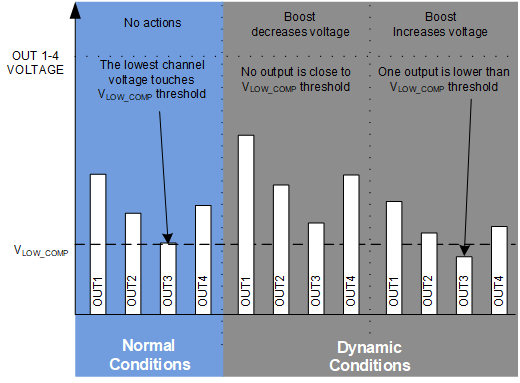ZHCSK37 August 2019 LP8867C-Q1 , LP8869C-Q1
PRODUCTION DATA.
- 1 特性
- 2 应用
- 3 说明
- 4 修订历史记录
- 5 Device Comparison Table
- 6 Pin Configuration and Functions
-
7 Specifications
- 7.1 Absolute Maximum Ratings
- 7.2 ESD Ratings
- 7.3 Recommended Operating Conditions
- 7.4 Thermal Information
- 7.5 Electrical Characteristics
- 7.6 Internal LDO Electrical Characteristics
- 7.7 Protection Electrical Characteristics
- 7.8 Current Sinks Electrical Characteristics
- 7.9 PWM Brightness Control Electrical Characteristics
- 7.10 Boost and SEPIC Converter Characteristics
- 7.11 Logic Interface Characteristics
- 7.12 Typical Characteristics
-
8 Detailed Description
- 8.1 Overview
- 8.2 Functional Block Diagram
- 8.3
Feature Description
- 8.3.1 Integrated DC-DC Converter
- 8.3.2 Internal LDO
- 8.3.3 LED Current Sinks
- 8.3.4 Protection and Fault Detections
- 8.4 Device Functional Modes
- 9 Application and Implementation
- 10Power Supply Recommendations
- 11Layout
- 12器件和文档支持
- 13机械、封装和可订购信息
8.3.1.2 Adaptive Voltage Control
The LP886xC-Q1 DC/DC converter generates the supply voltage for the LEDs. During normal operation, boost output voltage is adjusted automatically based on the LED cathode (OUTx pin) voltages. This is called adaptive boost control. Only the active LED outputs are monitored to control the adaptive boost voltage. Any LED strings with open or short faults are removed from the adaptive voltage control loop. The OUTx pin voltages are periodically monitored by the control loop. The boost voltage is raised if any of the OUTx voltage falls below the VLOW_COMP threshold. The boost voltage is also lowered if all OUTx voltages are higher than VLOW_COMP threshold. The boost voltage keeps unchanged when one of OUTx voltage touches the VLOW_COMP threshold. In normal operation, the lowest voltage among the OUTx pins is around VLOW_COMP, and boost voltage stays constant. VLOW_COMP level is the minimum voltage which could guarantee proper LED current sink operation. See Figure 10 for how the boost voltage automatically scales based on the OUT1-4 pin voltage.
 Figure 10. Adaptive Boost Voltage Control Loop Function
Figure 10. Adaptive Boost Voltage Control Loop Function